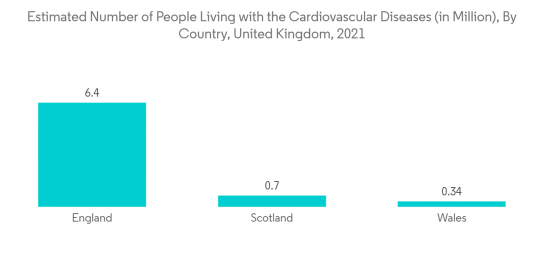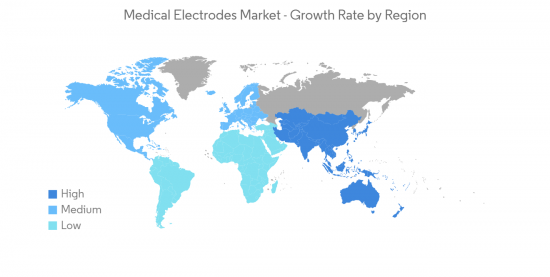
|
시장보고서
상품코드
1331345
세계의 의료용 전극 시장 규모 및 점유율 분석 - 성장 동향과 예측(2023-2028년)Global Medical Electrodes Market Size & Share Analysis - Growth Trends & Forecasts (2023 - 2028) |
||||||
의료용 전극 시장 규모는 2023년 9억 4,000만 달러에서 2028년 11억 4,000만 달러로 성장할 것으로 예상되며, 예측 기간(2023-2028년) 동안 4.10%의 CAGR을 기록할 것으로 예상됩니다.
주요 하이라이트
- COVID-19 팬데믹은 의료용 전극 시장에 큰 영향을 미쳤으며, 2022년 3월 Journal of Neurosurgical Anesthesiology 저널에 발표된 연구에 따르면, SARS-CoV-2가 중추신경계에 해로운 영향을 미치고 뇌파(EEG) 전극 전체 몽타주를 이용한 조사에서 COVID-19 감염과 관련된 비특이적 뇌파 이상을 발견했습니다.
- 또한 대부분의 COVID-19 환자는 짧은 전극 몽타주로 모니터링하는 동안 뇌파 불연속 증상을 보였기 때문에 COVID-19 환자에 대한 의료용 전극의 사용이 증가했습니다. 그러나 팬데믹 기간 동안 비응급 진단 및 치료 절차에 대한 수요는 감소했습니다. 그러나 병원 서비스 재개, 진단 절차 및 제품 가용성으로 인해 시장은 안정적인 속도로 성장하고 있습니다. 이러한 추세는 앞으로도 계속될 것으로 예상됩니다.
- 의료용 전극 시장의 성장은 주로 심혈관 및 신경 질환의 유병률 증가, 기술 발전 및 최소 침습 수술에 대한 관심 증가에 기인합니다. 뇌혈관 질환, 알츠하이머병, 치매, 편두통, 간질, 파상풍, 수막염, 파킨슨병, 다발성 경화증, 소아마비, 소아마비성 척수염과 같은 신경 질환의 증가는 신경 생리학적 경로에 대한 연구 증가로 이어져 의료용 전극의 채택을 증가시켜 시장 성장을 촉진할 것으로 예상됩니다. 알츠하이머병 협회가 2022년 3월 발표한 보고서에 따르면, 2023년 65세 이상 미국인 중 약 6억 7천만 명이 알츠하이머병에 걸릴 것으로 예상되며, 이 질병을 예방, 지연, 치료할 수 있는 의학적 돌파구가 개발되지 않는 한, 이 수치는 2030년까지 1 1,380만 명으로 증가할 수 있습니다.
- 또한 기업들은 효율적인 진단 및 치료 플랫폼 개발을 위해 과감한 투자를 하고 있으며, 이는 의료용 전극 시장의 유망한 성장 전망을 보여주고 있습니다. 이들 기업은 신제품 출시, M&A, 포트폴리오 확대 등 성장 전략에 집중하고 있습니다. 예를 들어, 2021년 9월 뉴로원 메디컬 테크놀로지스(Neuro One Medical Technologies Corporation)는 미국 식품의약국(FDA)으로부터 Evo sEEG 전극 기술의 판매 허가를 획득했습니다. 유망한 성과와 미충족 의료 수요의 다양한 분야에서 제품 승인 및 상용화를 위한 주요 의료기기 기업 간의 경쟁이 치열해짐에 따라 의료용 전극 시장이 성장할 것으로 예상됩니다.
- 그러나 의료용 전극의 생체 적합성, 엄격한 규제 지침, 적용 범위, 다양한 국가의 상이한 승인 절차는 의료용 전극 시장의 성장에 큰 장벽으로 작용하고 있습니다. 이러한 과제에도 불구하고 신경 질환의 부담 증가와 제품 출시는 예측 기간 동안 시장 성장을 촉진할 것으로 예상됩니다.
의료용 전극 시장 동향
심장학 부문은 예측 기간 동안 상당한 성장률을 보일 것으로 예상
- 전극은 가슴, 팔, 다리에 전략적으로 배치되고 리드선은 ECG 기기에 연결됩니다. 심장의 전기적 활동은 심장 마비, 심부전, 심내막염, 부정맥과 같은 심혈관 질환을 감지하기 위해 측정, 해석 및 인쇄됩니다. 각 심장주기 동안 전극은 심근의 탈분극과 재분극으로 인한 작은 전기적 변화를 감지합니다.
- 표준 12유도 심전도(ECG)는 심혈관계 질환의 평가에 널리 사용되며, 심장 리듬의 해석, 심근 허혈 및 심근경색, 전도계 이상, 전조증, QT 연장 증후군, 심방 이상, 심실 비대, 심막염 등을 감지하는 가장 중요한 검사 중 하나로 간주됩니다.
- 또한, 심장 질환의 유병률이 증가하고 있으며, 이는 시장 성장을 촉진할 것으로 예상됩니다. 영국 심장 재단의 2023년 2월 보고서에 따르면 2021년까지 영국에서 심장 및 순환기 질환을 앓고 있는 사람이 760만 명에 달할 것으로 예상됩니다. 전극은 심장의 전기적 활동을 기록, 분석 및 인쇄합니다. 따라서 심장 질환의 높은 부담은 예측 기간 동안 부문 확장을 촉진할 것으로 예상됩니다.
- 또한 심장병 전극에 대한 수요 증가, 연구 개발 노력 강화, 심장병 전극 기술 개선, 심장병 전극 사용의 이점에 대한 인식 확대 등이 심장병 전극 부문의 촉진요인이 될 것으로 예상됩니다. 예를 들어, 2021년 9월 Bittium은 Bittium OmegaSnap 패치 전극을 포함한 차세대 전극을 발표했는데, Bittium OmegaSnap 패치 전극은 사용자의 편안함을 염두에 두고 설계되어 전극을 교체할 필요 없이 최대 7일 동안 연속 심전도 측정을 위한 환자 친화적인 솔루션을 제공합니다. 환자 친화적인 솔루션을 제공합니다.
- 결론적으로, 심장 질환의 유병률 증가와 시장 진입 기업의 신제품 출시는 예측 기간 동안 심장 질환 전극 부문의 성장을 촉진할 것으로 예상됩니다.

예측 기간 동안 북미가 시장에서 큰 비중을 차지할 것으로 예상
- 북미 지역은 우수한 의료 인프라, 효과적인 정부 정책, 방대한 다국적 기업 기반, 의료 분야의 검사 및 검사 장비에 대한 높은 인식으로 인해 시장 조사에서 큰 점유율을 차지하고 있습니다. 이 지역은 또한 다른 만성 적응증에 비해 심혈관 질환, 당뇨병, 염증성 장 질환(IBD), 암과 같은 만성 염증성 질환의 유병률이 높은 지역입니다.
- 2021년 11월에 발표된 캐나다 정부 통계에 따르면 2021년에는 약 22만 9,200명의 캐나다인이 암 진단을 받을 것으로 예상되며, 전립선암은 전체 암 진단의 46%를 차지해 여전히 가장 많이 진단되는 암으로 남을 것으로 예상됩니다. 또한, 미국 질병예방통제센터(CDC)가 2022년 발표한 논문에 따르면, 미국에서는 2020년 20세 이상 성인 중 약 2,010만 명이 관상동맥질환을 앓고 있으며, 매년 약 805,000명이 심장마비를 앓고 있는 것으로 나타났습니다. 이에 따라 심혈관 질환에 대한 부담이 커짐에 따라 효과적인 진단에 대한 수요가 증가하여 예측 기간 동안 시장 성장을 촉진할 것으로 예상됩니다.
- 또한 여러 시장 진입 기업들이 제품 출시를 포함한 다양한 전략적 이니셔티브를 시행하고 있습니다. 예를 들어, 2021년 2월 Stratus Medical은 Nimbus RF Multitined Expandable Electrode와 관련된 세 번째 미국 특허를 취득했습니다. 미국 특허 10,925,664호는 "Methods For Radio Frequency Neurotomy"라는 제목으로 2021년 2월 23일 미국 특허청에 의해 발행되었습니다.
- 또한 2021년 5월, DC에 본사를 둔 스타트업 iCE Neuro Systems는 미국 식품의약국(USFDA)으로부터 두피 피부 아래에서 뇌의 전기적 활동을 모니터링하기 위해 설계된 iCE-SG라는 피하 전극에 대한 승인을 받았습니다.
- 따라서 만성질환 발병률 증가, 제품 출시 등 이러한 요인을 고려하면 조사 대상 시장은 예측 기간 동안 성장을 경험할 것으로 예상됩니다.

의료용 전극 산업 개요
의료용 전극 시장은 적당한 경쟁 상태에 있으며, 세계 기업과 현지 기업으로 구성되어 있습니다. 일부 유명 기업들은 전 세계적으로 시장 입지를 강화하기 위해 다른 기업과의 인수 및 합작 투자를 활발히 진행하고 있습니다. 3M, CONMED Corporation, Koninklijke Philips NV, Medtronic PLC, Natus Medical Inc. Inc, Natus Medical Corporation, 일본광전공업(주) 등이 이 시장의 주요 기업 중 일부입니다.
기타 혜택:
- 엑셀 형식의 시장 예측(ME) 시트
- 3개월간의 애널리스트 지원
목차
제1장 서론
- 조사 가정과 시장 정의
- 조사 범위
제2장 조사 방법
제3장 주요 요약
제4장 시장 역학
- 시장 개요
- 시장 성장 촉진요인
- 심혈관질환과 신경질환 유병률 증가
- 기술 진보 증가
- 최소침습 수술에 대한 주목 상승
- 시장 성장 억제요인
- 의료용 전극 생체적합성 문제
- 의료용 전극 관련 엄격한 규제 가이드라인
- Porter's Five Forces 분석
- 신규 참여업체의 위협
- 구매자/소비자의 협상력
- 공급 기업의 교섭력
- 대체품의 위협
- 경쟁 기업간 적대적 관계의 강도
제5장 시장 세분화(시장 규모 - 100만 달러)
- 제품 유형별
- 표면 전극
- 침 전극
- 사용성별
- 일회용 의료용 전극
- 재사용 가능 의료용 전극
- 모달리티 유형별
- 심전도(ECG)
- 뇌파(EEG)
- 근전도(EMG)
- 뇌간 청각 유발 전위(BAEPS)
- 기타 모달리티 유형
- 용도별
- 심장병학
- 신경생리학
- 수면장애
- 수술 중 모니터링
- 기타 용도
- 지역
- 북미
- 미국
- 캐나다
- 멕시코
- 유럽
- 독일
- 영국
- 프랑스
- 이탈리아
- 스페인
- 기타 유럽
- 아시아태평양
- 중국
- 일본
- 인도
- 호주
- 한국
- 기타 아시아태평양
- 중동 및 아프리카
- GCC
- 남아프리카공화국
- 기타 중동 및 아프리카
- 남미
- 브라질
- 아르헨티나
- 기타 남미
- 북미
제6장 경쟁 상황
- 기업 개요
- 3M
- Ad-Tech Medical Instrument Corporation
- Ambu AS
- Cognionics Inc.
- Cardinal Health
- CONMED Corporation
- Cooper Surgical Inc.
- Dymedix
- Koninklijke Philips NV
- DCC Healthcare(Leonhard Lang GmbH)
- Medtronic PLC
- Natus Medical Incorporated
- Nihon Kohden Corporation
제7장 시장 기회와 향후 동향
ksm 23.09.01The Medical Electrodes Market size is expected to grow from USD 0.94 billion in 2023 to USD 1.14 billion by 2028, at a CAGR of 4.10% during the forecast period (2023-2028).
Key Highlights
- The COVID-19 pandemic significantly impacted the medical electrodes market. A study published in the Journal of Neurosurgical Anesthesiology in March 2022 showed that SARS-CoV-2 had a detrimental impact on the central nervous system, with investigations using a full montage of electroencephalogram (EEG) electrodes revealing nonspecific EEG abnormalities associated with COVID-19 infection.
- Furthermore, most COVID-19 patients showed symptoms of EEG discontinuity during monitoring using a shortened electrode montage, resulting in increased use of medical electrodes for COVID-19 patients. However, the demand for non-emergency diagnosis and treatment procedures decreased during the pandemic. Nevertheless, the market is growing at a stable pace due to the resumption of hospital services, diagnosis procedures, and product availability. It is expected to continue this trend in the coming years.
- The growth of the medical electrodes market can mainly be attributed to the increasing prevalence of cardiovascular and neurological diseases, technological advancements, and a rising focus on minimally invasive surgeries. The rise in neurological conditions, including cerebrovascular disease, Alzheimer's, dementia, migraine, epilepsy, tetanus, meningitis, Parkinson's disease, multiple sclerosis, and poliomyelitis, is expected to lead to increased research on neurophysiological pathways, resulting in higher adoption of medical electrodes and boosting market growth. According to a report published by the Alzheimer's Association in March 2022, Alzheimer's dementia is expected to affect an estimated 6.7 million Americans aged 65 and above in 2023, and this figure may rise to 13.8 million by 2060 unless medical breakthroughs are developed to prevent, delay, or cure the disease.
- In addition, companies are making rigorous investments toward the development of efficient diagnostic and therapeutic platforms, indicating promising growth prospects for the medical electrode market. These companies are focusing on growth strategies such as new product launches, mergers and acquisitions, and portfolio expansion. For example, in September 2021, NeuroOne Medical Technologies Corporation received Food and Drug Administration (FDA) clearance to market its Evo sEEG Electrode technology. Promising outcomes and increasing competition among leading medical device companies to approve and commercialize products in different areas of unmet medical needs are expected to boost the medical electrodes market.
- However, the biocompatibility of medical electrodes and the stringent regulatory guidelines, coverage, and different approval processes in various countries are significant barriers to the medical electrode market's growth. Despite these challenges, the growing burden of neurological diseases and product launches are expected to propel the market's growth over the forecast period.
Medical Electrodes Market Trends
Cardiology Segment Expected to Witness Significant Growth Rate Over the Forecast Period
- Electrodes are strategically placed on the chest, arms, and legs, and the lead wires connect them to ECG equipment. The electrical activity of the heart is measured, interpreted, and printed to detect cardiovascular events such as heart attacks, heart failure, endocarditis, irregular heartbeats, and others. During each cardiac cycle, the electrodes detect the small electrical changes caused by heart muscle depolarization and repolarization.
- The standard 12-lead electrocardiogram (ECG) is widely used in assessing cardiovascular diseases and is considered one of the most important tests for interpreting cardiac rhythm, detecting myocardial ischemia and infarction, conduction system abnormalities, preexcitation, long QT syndromes, atrial abnormalities, ventricular hypertrophy, pericarditis, and other conditions.
- Moreover, the prevalence of heart diseases is growing, which is expected to fuel the market's growth. According to a February 2023 report by the British Heart Foundation, there were 7.6 million people with heart and circulation illnesses in the UK by 2021. The electrodes record, analyze and print the heart's electrical activity. Therefore, the high burden of cardiac illnesses is anticipated to drive segment expansion over the forecast period.
- Furthermore, increasing demand for cardiology electrodes, intensified R&D efforts, improvements in cardiology electrode technology, and expanding awareness about the benefits of using cardiology electrodes are significant factors predicted to drive the cardiology electrodes segment. For example, in September 2021, Bittium introduced a new generation of electrodes, including the Bittium OmegaSnap patch electrodes, designed with user comfort in mind to provide a patient-friendly solution for continuous ECG measurements for up to 7 days without needing to replace the electrode.
- In conclusion, the growing prevalence of cardiac diseases and the introduction of new products by market players are expected to drive the growth of the cardiology electrodes segment over the forecast period.

North America Expected to Hold a Significant Share in the Market Over the Forecast Period
- The North American region commands a significant share of the market studied, primarily due to its superior healthcare infrastructure, effective government policies, vast multinational company base, and a high level of awareness about testing and testing devices in healthcare. This region also witnesses a high prevalence of chronic inflammatory disorders, such as cardiovascular diseases, diabetes, inflammatory bowel disease (IBD), and cancer, compared to other chronic indications.
- According to the Government of Canada's statistics published in November 2021, approximately 229,200 Canadians were diagnosed with cancer in 2021, with prostate cancer expected to remain the most diagnosed cancer, accounting for 46% of all cancer diagnoses. Furthermore, a 2022 article published by the Centers for Disease Control and Prevention (CDC) reveals that about 20.1 million adults aged 20 years and older had coronary artery disease in the United States in 2020, and each year, around 805,000 people in the United States have a heart attack. As a result, the high burden of cardiovascular diseases is anticipated to drive the demand for effective diagnosis and fuel market growth in this country over the forecast period.
- In addition, several market players are implementing various strategic initiatives, including product launches. For example, in February 2021, Stratus Medical was granted a third US patent related to its Nimbus RF Multitined Expandable Electrode. US Patent No. 10,925,664, titled "Methods For Radio Frequency Neurotomy," was issued on February 23, 2021, by the United States Patent and Trademark Office.
- Furthermore, in May 2021, a DC-based startup, iCE Neuro Systems, received approval from the United States Food and Drug Administration (USFDA) for a subcutaneous electrode called iCE-SG, designed to monitor the brain's electrical activity from beneath the skin of the scalp.
- Therefore, considering these factors, such as rising chronic disease incidence and product launches, the market studied is expected to experience growth over the forecast period.

Medical Electrodes Industry Overview
The medical electrodes market is moderately competitive and consists of global and local players. Some prominent players are vigorously making acquisitions and joint ventures with other companies to consolidate their market positions across the world. Due to the increase in cardiovascular and neurological diseases across the world, companies are coming up with novel products to cater to consumers across different geographies. 3M, CONMED Corporation, Koninklijke Philips NV, Medtronic PLC, Natus Medical Incorporated, and Nihon Kohden Corporation are some of the major players in the market.
Additional Benefits:
- The market estimate (ME) sheet in Excel format
- 3 months of analyst support
TABLE OF CONTENTS
1 INTRODUCTION
- 1.1 Study Assumptions and Market Definition
- 1.2 Scope of the Study
2 RESEARCH METHODOLOGY
3 EXECUTIVE SUMMARY
4 MARKET DYNAMICS
- 4.1 Market Overview
- 4.2 Market Drivers
- 4.2.1 Increasing Prevalence of Cardiovascular and Neurological Diseases
- 4.2.2 Increasing Technological Advancements
- 4.2.3 Rising Focus toward Minimally Invasive Surgeries
- 4.3 Market Restraints
- 4.3.1 Biocompatibility Issues with Medical Electrodes
- 4.3.2 Stringent Regulatory Guidelines Associated with Medical Electrodes
- 4.4 Porter's Five Forces Analysis
- 4.4.1 Threat of New Entrants
- 4.4.2 Bargaining Power of Buyers/Consumers
- 4.4.3 Bargaining Power of Suppliers
- 4.4.4 Threat of Substitute Products
- 4.4.5 Intensity of Competitive Rivalry
5 MARKET SEGMENTATION (Market Size by Value - USD million)
- 5.1 By Product Type
- 5.1.1 Surface Electrodes
- 5.1.2 Needle Electrodes
- 5.2 By Usability
- 5.2.1 Disposable Medical Electrodes
- 5.2.2 Reusable Medical Electrodes
- 5.3 By Modality Type
- 5.3.1 Electrocardiography (ECG)
- 5.3.2 Electroencephalography (EEG)
- 5.3.3 Electromyography (EMG)
- 5.3.4 Brainstem Auditory Evoked Potentials (BAEPS)
- 5.3.5 Other Modality Types
- 5.4 By Application
- 5.4.1 Cardiology
- 5.4.2 Neurophysiology
- 5.4.3 Sleep Disorders
- 5.4.4 Intraoperative Monitoring
- 5.4.5 Other Applications
- 5.5 Geography
- 5.5.1 North America
- 5.5.1.1 United States
- 5.5.1.2 Canada
- 5.5.1.3 Mexico
- 5.5.2 Europe
- 5.5.2.1 Germany
- 5.5.2.2 United Kingdom
- 5.5.2.3 France
- 5.5.2.4 Italy
- 5.5.2.5 Spain
- 5.5.2.6 Rest of Europe
- 5.5.3 Asia-Pacific
- 5.5.3.1 China
- 5.5.3.2 Japan
- 5.5.3.3 India
- 5.5.3.4 Australia
- 5.5.3.5 South Korea
- 5.5.3.6 Rest of Asia-Pacific
- 5.5.4 Middle East and Africa
- 5.5.4.1 GCC
- 5.5.4.2 South Africa
- 5.5.4.3 Rest of Middle East and Africa
- 5.5.5 South America
- 5.5.5.1 Brazil
- 5.5.5.2 Argentina
- 5.5.5.3 Rest of South America
- 5.5.1 North America
6 COMPETITIVE LANDSCAPE
- 6.1 Company Profiles
- 6.1.1 3M
- 6.1.2 Ad-Tech Medical Instrument Corporation
- 6.1.3 Ambu AS
- 6.1.4 Cognionics Inc.
- 6.1.5 Cardinal Health
- 6.1.6 CONMED Corporation
- 6.1.7 Cooper Surgical Inc.
- 6.1.8 Dymedix
- 6.1.9 Koninklijke Philips NV
- 6.1.10 DCC Healthcare (Leonhard Lang GmbH)
- 6.1.11 Medtronic PLC
- 6.1.12 Natus Medical Incorporated
- 6.1.13 Nihon Kohden Corporation

















